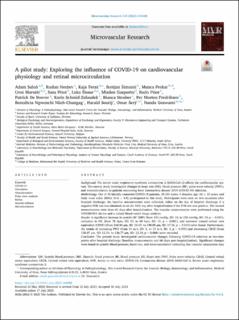A pilot study: Exploring the influence of COVID-19 on cardiovascular physiology and retinal microcirculation
Salon, Adam; Neshev, Ruslan; Teraž, Kaja; Šimunič, Boštjan; Peskar, Manca; Marušič, Uroš; Pišot, Saša; Šlosar, Luka; Gasparini, Mladen; Pišot, Rado; De Boever, Patrick; Schmid-Zalaudek, Karin; Steuber, Bianca; Fredriksen, Per Morten; Nkeh-Chungag, Benedicta Ngwenchi; Sourij, Harald; Šerý, Omar; Goswami, Nandu
Peer reviewed, Journal article
Published version
Permanent lenke
https://hdl.handle.net/11250/3106535Utgivelsesdato
2023Metadata
Vis full innførselSamlinger
Sammendrag
Background The severe acute respiratory syndrome coronavirus 2 (SARS-CoV-2) affects the cardiovascular system. The current study investigated changes in heart rate (HR), blood pressure (BP), pulse wave velocity (PWV), and microcirculation in patients recovering from Coronavirus disease 2019 (COVID-19) infection. Methodology Out of 43 initially contacted COVID-19 patients, 35 (30 males, 5 females; age: 60 ± 10 years; and body mass index (BMI): 31.8 ± 4.9) participated in this study. Participants were seen on two occasions after hospital discharge; the baseline measurements were collected, either on the day of hospital discharge if a negative PCR test was obtained, or on the 10th day after hospitalization if the PCR test was positive. The second measurements were done 60 days after hospitalization. The vascular measurements were performed using the VICORDER® device and a retinal blood vessel image analysis. Results A significant increase in systolic BP (SBP) (from 142 mmHg, SD: 15, to 150 mmHg, SD: 19, p = 0.041), reduction in HR (from 76 bpm, SD: 15, to 69 bpm, SD: 11, p = 0.001), and narrower central retinal vein equivalent (CRVE) (from 240.94 μm, SD: 16.05, to 198.05 μm, SD: 17.36, p = 0.013) were found. Furthermore, the trends of increasing PWV (from 11 m/s, SD: 3, to 12 m/s, SD: 3, p = 0.095) and decreasing CRAE (from 138.87 μm, SD: 12.19, to 136.77 μm, SD: 13.19, p = 0.068) were recorded. Conclusion The present study investigated cardiovascular changes following COVID-19 infection at two-time points after hospital discharge (baseline measurements and 60 days post-hospitalization). Significant changes were found in systolic blood pressure, heart rate, and microvasculature indicating that vascular adaptations may be ongoing even weeks after hospitalization from COVID-19 infection. Future studies could involve conducting additional interim assessments during the active infection and post-infection periods.

